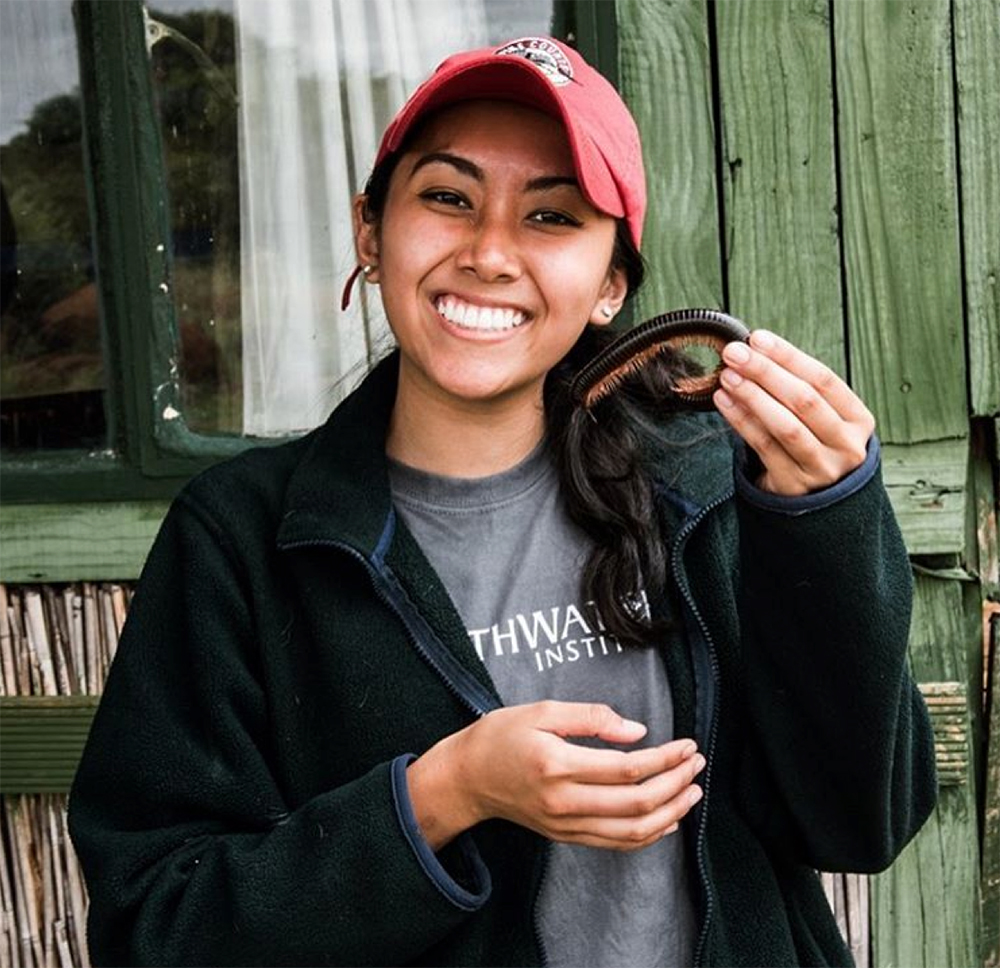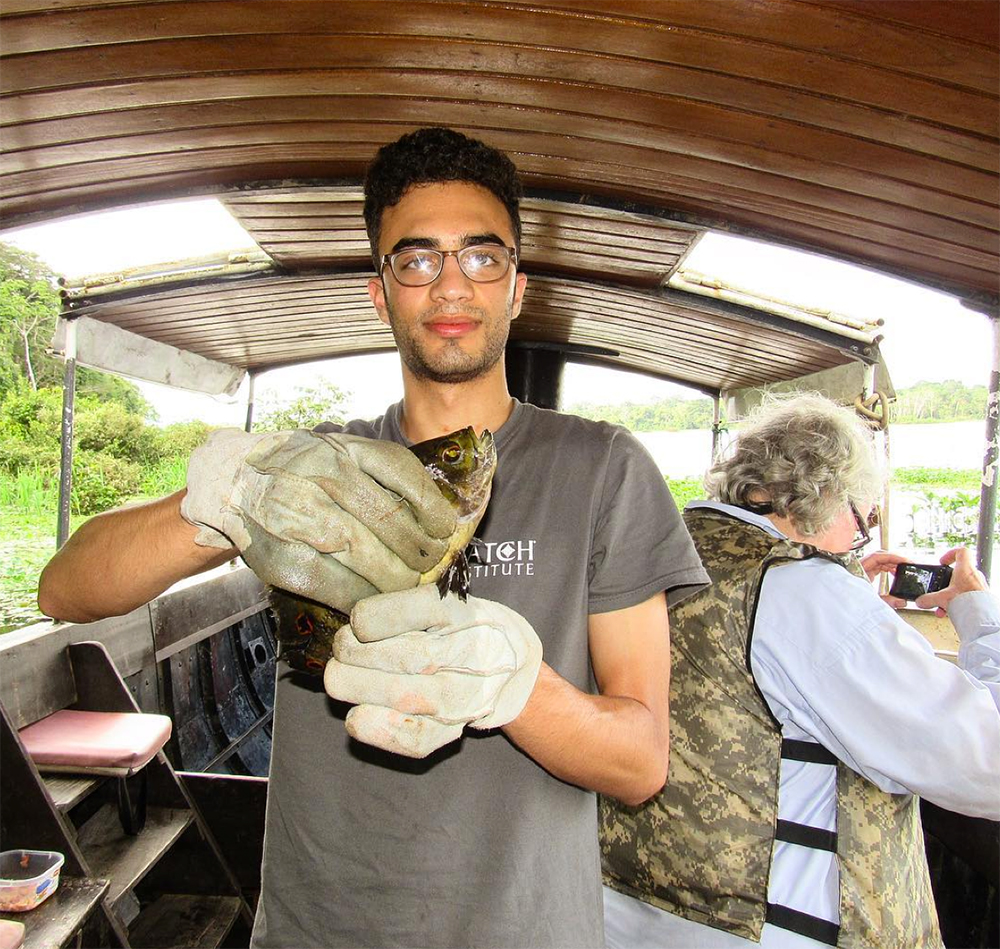Students survey beetles, piranha, sharks for Earthwatch
By Blaine Friedlander

Nicole Tu-Maung’s research on a South African nature reserve sought to document the complex ecology of white rhinos by collecting and examining the beetles feasting on the animals’ dung.
“It was the hellish orchestra of several hundred beetles, scraping their serrated legs on the hard exteriors of their fellow captives; clawing and biting desperately at each other to make way toward the edge of the bag only to be trapped and crushed under the weight of several kilos of sloshing, wet dung,” wrote Tu-Maung in her post-expedition blog.
Tu-Maung ’17, Megan Joyce ’17 and Sinan-Saleh Kassam ’17 – all environmental and sustainability sciences majors – journeyed to three points around the globe to conduct hands-on research in January via Earthwatch, a group that brings volunteers together to conduct research.
Conservation ecologist Stephen Morreale, senior research associate and adjunct associate professor in natural resources, administers the partnership with Earthwatch on behalf of Cornell with funding from Muriel K. Horacek in honor of her late husband, Fred Horacek ’51. This is the first year of the partnership program between Cornell and Earthwatch.
The students were immersed in studies on science and the environment. Along the Amazon River in Peru’s Pacaya-Samiria National Reserve, Kassam researched and assessed the long-term impact of climate change on the region’s river dolphins, primates, amphibians, caimans, macaws, manatee, jaguars and wading birds.
“I got to catch and measure caimans at night. We caught piranhas, but many of us accidentally lost them,” said Kassam, who worked with Richard Bodmer of the University of Kent, England. “We saw an anaconda eating a black caiman, which was incredible and very rare. We saw a monkey swimming – which is also very rare. We also got to spend time in the local village learning new cultures.”
Kassam also wrote, “Aside from witnessing the absolutely incredible ecology of the Peruvian amazon and having the privilege learning from a community of indigenous Cocoma, what was most important … was being exposed to a new way of thinking.”

At the Glover’s Reef atoll off the coast of Belize, Joyce worked with Demian Chapman and Katie Flowers, both affiliated with Florida International University and Global FinPrint. Working with these international researchers, Joyce studied shark and ray populations, catching and tagging Caribbean reef sharks and observing rays with Baited Underwater Remote Video cameras, or BRUVs.
While ostensibly studying the marine environment, Joyce also learned about humans – specifically about volunteers who want to contribute. “You can’t have marine conservation without the support of people,” she said.
Joyce and her volunteer colleagues installed temporary BRUVs, setting them underwater for about 90 minutes, to capture video of Caribbean marine life. In her blog she writes, “We went snorkeling after breakfast … we saw a nurse shark, a southern stingray, lots of spiny lobster, an upside-down jelly, and tons of cool fish in the patch reefs.” Once, her team was setting the underwater cameras when a colleague spotted a school of dog snapper fish. “We jumped into the water, snorkeled and watched them spawn – a very cool experience,” she said.
Tu-Maung, working with Anja Rott of the University of Brighton, England, sought to understand how individual rhino behavior and grazing habits (consuming different vegetation) might change due to the loss of its horn. For Tu-Maung, that meant digging into dung and examining the species diversity of dung beetles.
Tu-Maung had conducted earthworm identification research for Bernd Blossey, associate professor of natural resources, and she banded geese and terns in other research. “There ends up being a lot of poop involved with fieldwork,” she said.

In her blog, Tu-Maung wrote of greeting sunrises, seeing zebra and walking through thorny grasses. Sometimes science is romantic, as she learned years ago, surrounded by miles of grasses speckled with acacias, and wrote: “My heart is full when it’s in the field.”
But then it was back to reporting on science. “We’d fill the bags with rhino excrement … and set them out in plots. As condensation filled the plastic, the steamy aroma would wander out of the pits, charming thousands of beetles like a lurid temptress singing her siren’s song,” she blogged. “After collecting the bags, we’d empty them into trays, separate the overwhelming masses of insects from the pungent, wet feces, stuff the beetles into vials and store them in the fridge – right next to our six packs of beer – because who doesn’t need a drink after that?”
Media Contact
Get Cornell news delivered right to your inbox.
Subscribe